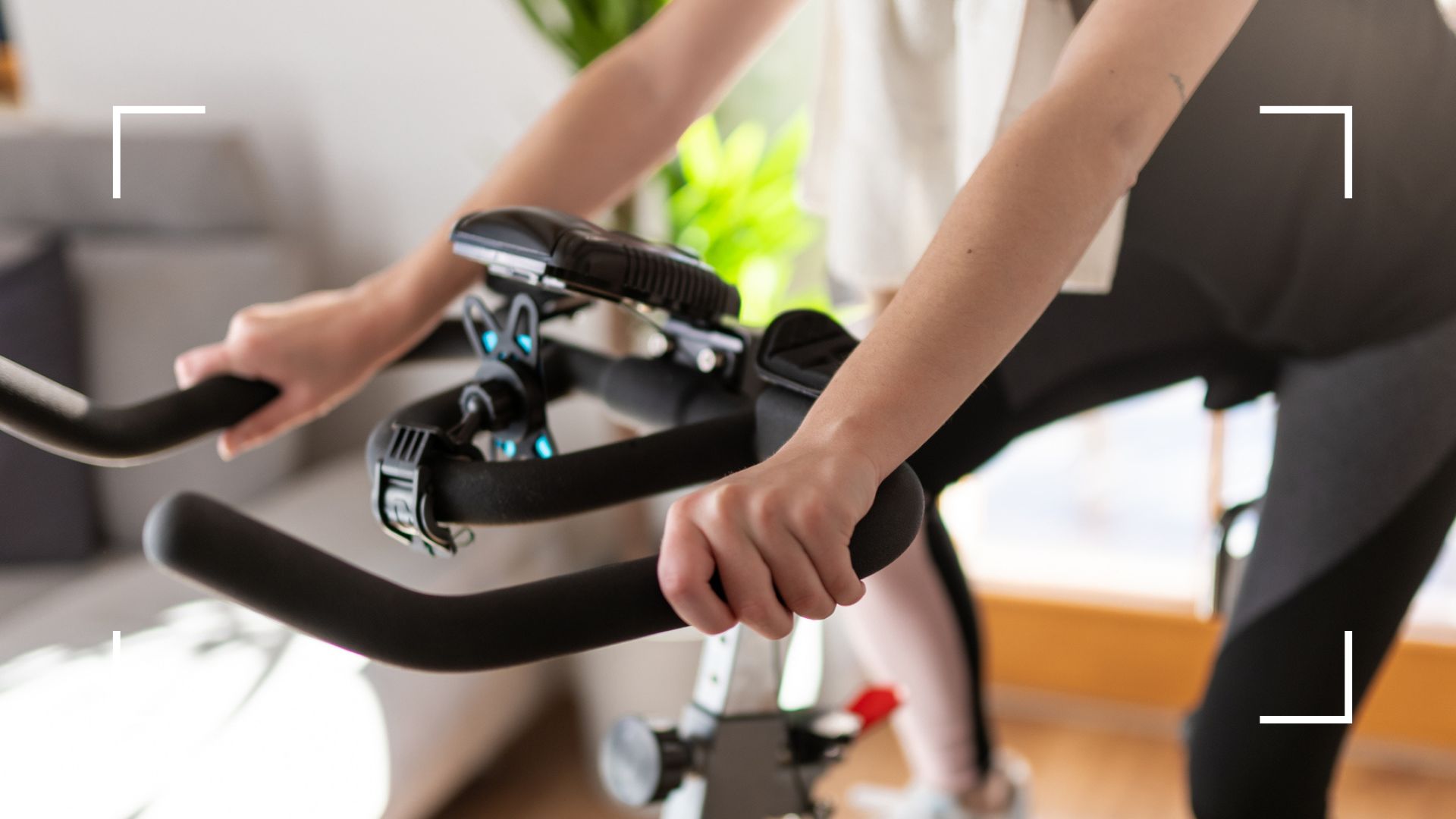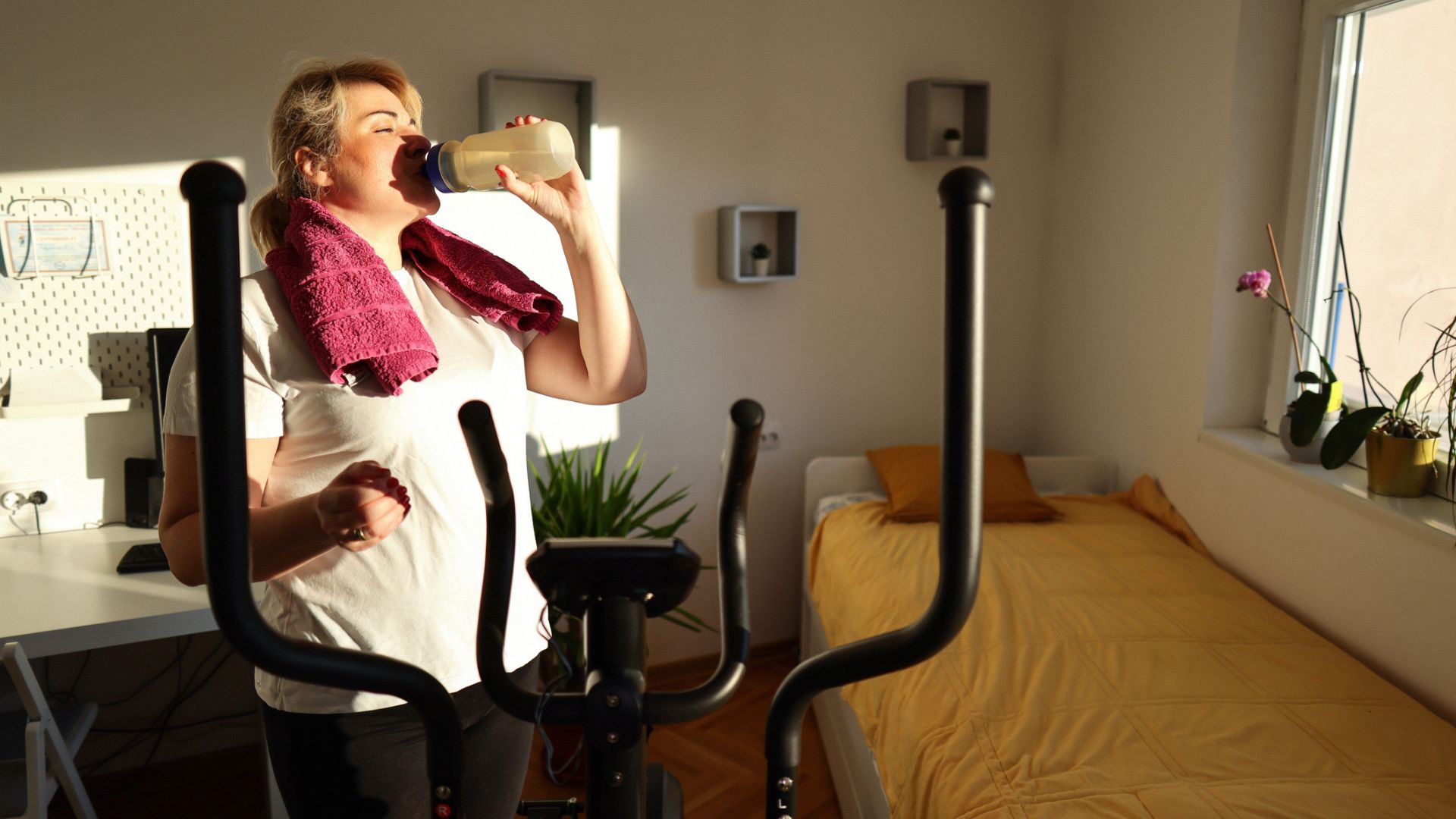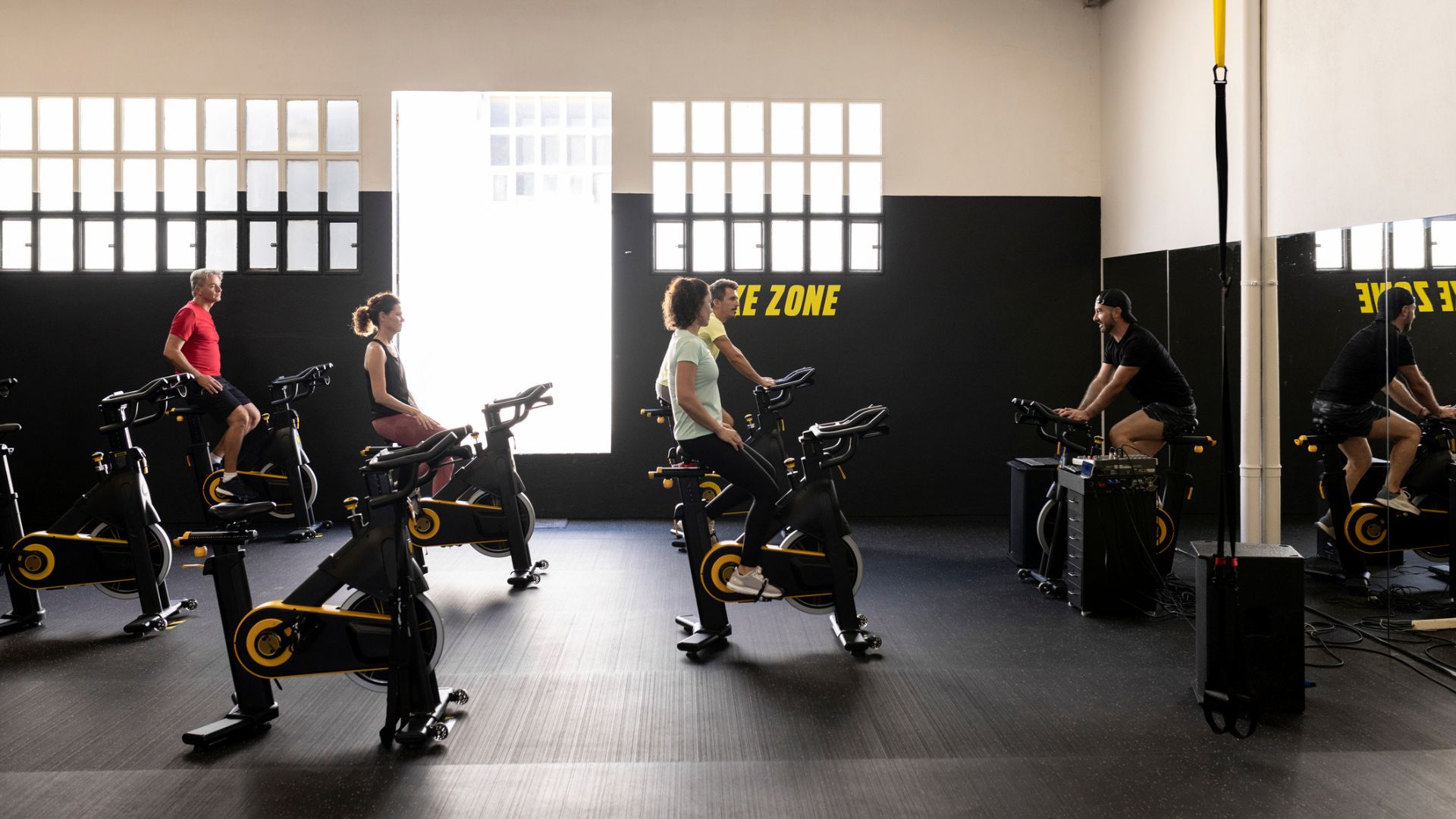What's the link between cycling and pelvic floor issues? This is what I wish I'd known before getting on the bike
Writer Jennifer Barton discovered the link between cycling and pelvic floor problems when she injured her sacrum. Here, with the help of top specialists, she explains all you need to know


Unless you're a keen cyclist who's been riding for years, the potential link between cycling and pelvic floor health is one you may not think about too much - until things start to go wrong. At least, that's my experience.
As an avid Peloton user who cycled three to five times a week, cycling was my favourite way to work out. I loved the fact it was cardio exercise but low impact, high on joy but easy on my joints. That was until I injured my sacrum (a triangular-shaped bone that sits between the hips and the last bone of the spine, just above the coccyx or 'tailbone') doing the London equivalent of slipping on a banana peel: I fell over on rain-slicked pavement while walking and landed on my sacrum. Yes, ouch is right. It was excruciating. As I let the injury recover over a slow 12 weeks, my doctor told me to try out different types of exercise and see how I felt. So, a couple of months into the healing process, I hopped back on my beloved Peloton bike to try and get back into cycling as a workout.
The ride itself was fine (exhilarating, even) but afterwards, I felt weird. Well, more precisely: I felt nothing. I had no sensation in my pelvic floor area at all. I started to wonder whether there might be a link between the cycling I was doing and these pelvic floor issues, so I went to see Megan Vickers, a women’s health physiotherapist specialising in spinal and pelvic issues. She told me my sacral nerve was bruised from the blunt trauma of my injury and when I'd gotten back on the bike, I'd sat on a nerve that was already bruised. As Vickers, who is also the director of Four Sides London explains it: “It was squished and trapped, and then you kind of trapped it more. It was struggling to get the messages through.”
It's a problem since irritating this nerve can lead to all kinds of uncomfortable symptoms - like the numbness I experienced, pins and needles, and pain around the pelvic region - and some longer-term issues like changes to bowel, bladder, or sexual function, per research by Creighton University School of Medicine.
Considering the popularity of fitness classes like spinning and indoor cycling generally, I was surprised to learn this wasn't something many people knew about. So, if you're looking to experience all the benefits of cycling out there - without doing damage to your pelvic floor - this is what you need to know. From all the expert info on the link between cycling and pelvic floor muscles to how cycling can, with the right modifications, actually benefit your pelvic floor as well, we've got you covered.
What is the link between cycling and pelvic floor dysfunction?
When it comes to assessing the relationship between cycling and pelvic floor dysfunction, it’s first important to understand what is meant by pelvic floor dysfunction as it can be understood in one of two ways, explains pelvic health physiotherapist Grace Covington. “Either people have a lot of tension in their pelvic floor and a lot of pain, or it can be the other end of the spectrum where people have weakness, which most people associate with things like urine leaking.”
Covington, who practices at Marylebone Health Group, explains, "It’s definitely more the pain and tension side of things that’s a problem with cycling." If you’re in this group, you may already know it. People who experience pain during sex and smear tests, those with a history of difficulty and discomfort using tampons or moon cups, may find cycling causes them discomfort, too.
Sign up to our free daily email for the latest royal and entertainment news, interesting opinion, expert advice on styling and beauty trends, and no-nonsense guides to the health and wellness questions you want answered.
Another category of those affected by cycling and pelvic floor issues are those who have done too much, too soon, like started spinning obsessively every day or gone from doing little to no exercise to cycling outside multiple times a week.
“It’s that repetitive cycling over a longer period that can start to cause issues. They start getting pain, feelings of tightness, and perhaps they can’t wear the same underwear they used to wear because it feels uncomfortable and doesn't quite feel right anymore,” Covington says.

It’s tricky to say whether cycling is the cause of these pelvic health issues or whether the exercise simply exacerbates them as the science isn't really behind it yet, so a lot of the stories are anecdotal.
But if you’re someone who already has scarring or sensitivity in the area, be careful. “That can create quite a bit of pressure and soreness, just from sitting on the saddle,” says Vickers, noting that the saddle affects the heating in that area, which can also cause discomfort. The repetitive motion of cycling goes through the hip joints, which are also connected to the pelvic floor.
“If your capacity is down, if your ability to train the pelvic floor is down from a recent infection, a recent operation, a pregnancy, a postnatal recovery, any kind of rehab for the pelvic floor, it's going to get tired like the rest of the body,” says Vickers, who compares pelvic floor fatigue to going for a run when your body isn’t ready for it. In either case, this can lead to either spasms or post-exercise weakness, such as bladder issues.
Is cycling bad for your pelvic floor?
Most cases of cycling and pelvic floor issues tend to vary on an individual basis but there is some research to back up the idea that constant cycling, multiple times a week for hours at a time, may have some negative impact on your pelvic floor.
For example, a study from Loyola University Health System found that one in three female triathletes had a pelvic floor disorder (urinary incontinence, bowel incontinence or pelvic organ prolapse), while researchers from the Rural School of Public Health in Texas found links between cycling and pelvic floor issues, based on where the handlebars are positioned. The study concluded that if they were lower than the saddle, it could cause an increase in perineum saddle pressures and a decrease in sensation.
According to Vickers, “if you’ve done too much too soon” on the bike, you’re likely to know within about 24 hours of finishing your ride. The signs to look out for, she says, are:
- A dull, hard-to-pinpoint ache or pain, which may refer to the hips and/or lower back
- Hesitation when going to the toilet, where you won't be able to empty your bladder or bowels as easily
- Those who are post-partum, post-surgery, or post-injury may find they have "accidental leaks if they cough or sneeze, and more of an urgency to go to the loo because their pelvic floor resting tone is down," she says.
There are many benefits of cycling and, in many ways, the difference between indoor and outdoor cycling is minimal. But interestingly, the type of cycling you do can affect your pelvic floor in different ways.
“Generally, outdoors, you're going to have a bit more vibration, bumps in the road, a change of terrain. That vibration element can be troubling for some people if they have any bladder issues,” says Covington.
By contrast, on an indoor bike or in a spin class, “you're standing up, in and out of the saddle, so you're getting better blood flow and circulation to the vulva. When you're sitting for a long time on your road bike outdoors, it's that reduction in circulation that can be a bit problematic for people,” she adds.

Is cycling good for pelvic floor muscles?
Despite some established links between cycling and pelvic floor issues, cycling happens to be a workout many physios recommend. “On a Peloton [and other indoor spinning bikes], in particular, it's quite repetitive. You can take it nice and steady, and you can control the resistance yourself,” explains Vickers. “As long as you are mindful of it, you can manage the load and increase it in a really nice way.”
Vickers feels cycling is a particularly good exercise for those in perimenopause because it’s “resistance-based,” so helps with muscle building and bone density. “And obviously the pelvic floor requires muscle building, and the pelvis needs to be nice and strong from a bone density nature as well,” she adds.
When done in a safe and controlled way, cycling can even be better than walking since your feet remain attached to the bike, exposing your joints to less impact. “For most people, cycling can be a really good form of exercise,” agrees Covington, adding that low-impact activity such as this is a great way for those struggling with their pelvic floor to get a cardio hit since more upright, cardio-based workouts, like running or cross-training, can be tricky with pelvic floor weakness.
However, she stresses cycling shouldn’t be the only activity you’re doing. “Cycling involves a lot of sitting and leaning forward, so doing something that opposes that - swimming as a workout, Pilates, strength training - alongside it would be a really good combo. There are loads of benefits in terms of being a low-impact exercise for people that's usually quite accessible,” Covington adds.
Tips for cycling safely
- Swap your saddle: “Most saddles are made for men," explains Vickers. "There is one saddle for men and women and when you think about our anatomy, that doesn't make any sense. Optimize your saddle to minimize cycling and pelvic floor issues by using gel cushions for comfort and avoiding saddles with a cutout."
- Get a bike fit: Whether you’re cycling indoors or outdoors, ensure your bike fits your body well. If you're buying a bike to ride outdoors, make sure you buy from a retailer that offers a bike fit as part of the set-up process. If you're buying one to ride indoors, be sure to check with the manufacturer's guidance that you're positioned correctly on the bike.
- Pad it up: Shorts with a chamois, a pad in the bottom of the shorts to protect the buttocks and pelvic region, or a pair of the best workout leggings designed for cycling can provide extra comfort.
- Stretch it out: Don’t neglect your stretch. Make sure to target your hips and the muscles that attach to the pelvis after your ride. Using one of the best stretching apps can help you do this right.
- Don’t ignore any niggles: I'm very glad I booked in with a pelvic floor specialist when I did, so I'd recommend doing the same. Even if you think it could be another issue, consult a pelvic health specialist if anything seems wrong.
- Spend time exercising your pelvic floor off the bike: I ended up buying a Kegel8 pelvic toner, one of the best pelvic floor trainers, to regain sensation in my pelvic floor - and I found it worked within just a few uses.
Jennifer is a London-based freelance journalist, originally from New York. Her byline has appeared in British Vogue, Stylist, WIRED, Grazia and others. She spent a decade training to become a professional ballet dancer and loves to write on all things fitness and wellbeing, from skateboarding to spin class. Jennifer is passionate about mental wellbeing, too, especially when it comes to destigmatizing the shame and silence around mental health conditions.
